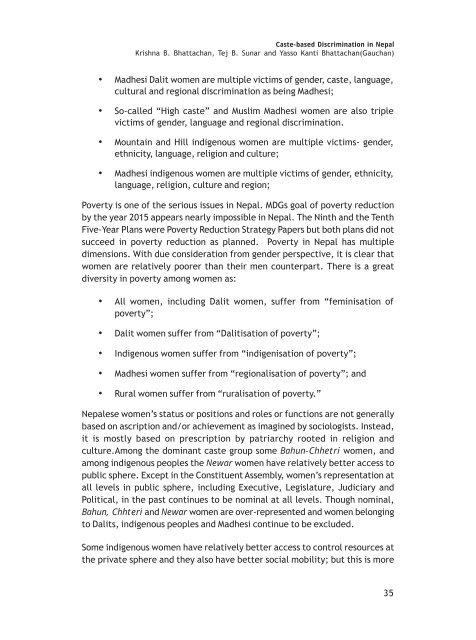Caste-based discrimination in Nepal - International Dalit Solidarity ...
Caste-based discrimination in Nepal - International Dalit Solidarity ...
Caste-based discrimination in Nepal - International Dalit Solidarity ...
Create successful ePaper yourself
Turn your PDF publications into a flip-book with our unique Google optimized e-Paper software.
<strong>Caste</strong>-<strong>based</strong> Discrim<strong>in</strong>ation <strong>in</strong> <strong>Nepal</strong><br />
Krishna B. Bhattachan, Tej B. Sunar and Yasso Kanti Bhattachan(Gauchan)<br />
• Madhesi <strong>Dalit</strong> women are multiple victims of gender, caste, language,<br />
cultural and regional <strong>discrim<strong>in</strong>ation</strong> as be<strong>in</strong>g Madhesi;<br />
• So-called “High caste” and Muslim Madhesi women are also triple<br />
victims of gender, language and regional <strong>discrim<strong>in</strong>ation</strong>.<br />
• Mounta<strong>in</strong> and Hill <strong>in</strong>digenous women are multiple victims- gender,<br />
ethnicity, language, religion and culture;<br />
• Madhesi <strong>in</strong>digenous women are multiple victims of gender, ethnicity,<br />
language, religion, culture and region;<br />
Poverty is one of the serious issues <strong>in</strong> <strong>Nepal</strong>. MDGs goal of poverty reduction<br />
by the year 2015 appears nearly impossible <strong>in</strong> <strong>Nepal</strong>. The N<strong>in</strong>th and the Tenth<br />
Five-Year Plans were Poverty Reduction Strategy Papers but both plans did not<br />
succeed <strong>in</strong> poverty reduction as planned. Poverty <strong>in</strong> <strong>Nepal</strong> has multiple<br />
dimensions. With due consideration from gender perspective, it is clear that<br />
women are relatively poorer than their men counterpart. There is a great<br />
diversity <strong>in</strong> poverty among women as:<br />
• All women, <strong>in</strong>clud<strong>in</strong>g <strong>Dalit</strong> women, suffer from “fem<strong>in</strong>isation of<br />
poverty”;<br />
• <strong>Dalit</strong> women suffer from “<strong>Dalit</strong>isation of poverty”;<br />
• Indigenous women suffer from “<strong>in</strong>digenisation of poverty”;<br />
• Madhesi women suffer from “regionalisation of poverty”; and<br />
• Rural women suffer from “ruralisation of poverty.”<br />
<strong>Nepal</strong>ese women’s status or positions and roles or functions are not generally<br />
<strong>based</strong> on ascription and/or achievement as imag<strong>in</strong>ed by sociologists. Instead,<br />
it is mostly <strong>based</strong> on prescription by patriarchy rooted <strong>in</strong> religion and<br />
culture.Among the dom<strong>in</strong>ant caste group some Bahun-Chhetri women, and<br />
among <strong>in</strong>digenous peoples the Newar women have relatively better access to<br />
public sphere. Except <strong>in</strong> the Constituent Assembly, women’s representation at<br />
all levels <strong>in</strong> public sphere, <strong>in</strong>clud<strong>in</strong>g Executive, Legislature, Judiciary and<br />
Political, <strong>in</strong> the past cont<strong>in</strong>ues to be nom<strong>in</strong>al at all levels. Though nom<strong>in</strong>al,<br />
Bahun, Chhteri and Newar women are over-represented and women belong<strong>in</strong>g<br />
to <strong>Dalit</strong>s, <strong>in</strong>digenous peoples and Madhesi cont<strong>in</strong>ue to be excluded.<br />
Some <strong>in</strong>digenous women have relatively better access to control resources at<br />
the private sphere and they also have better social mobility; but this is more<br />
35

















